For the full use of fish by-products to produce antioxidant peptides, skipjack tuna (
Katsuwonus pelamis) heads generated during can processing were defatted and hydrolyzed using the in vitro gastrointestinal (GI) digestion (pepsin–trypsin system) method and six antioxidant peptides (P1 to P6) were purified from the head hydrolysate (KPH) using ultrafiltration and serial chromatography methods. Six isolated peptides (P1 to P6) were identified as Val-Glu-Glu (VEE, P1), Trp-Met-Phe-Asp-Trp (WMFDW, P2), Asp-Ala-Gly-Pro-Tyr-Gly-Pro-Ile (DAGPYGPI, P3), Trp-Met-Gly-Pro-Tyr (WMGPY, P4), Glu-Arg-Gly-Pro-Leu-Gly-Pro-His (ERGPLGPH, P5), and Glu-Met- Gly-Pro-Ala (EMGPA, P6), respectively, using a protein sequencer and electrospray ionization-mass spectrometer. Among skipjack tuna head hydrolysates, fractions, and six isolated peptides (P1 to P6), WMFDW (P2), WMGPY (P4), and EMGPA (P6) showed the highest radical scavenging activities on 2,2-diphenyl-1-picrylhydrazyl (DPPH) (EC
50 values of 0.31, 0.33, and 0.46 mg/mL for WMFDW, WMGPY, and EMGPA, respectively), hydroxyl (EC
50 values of 0.30, 0.43, and 0.52 mg/mL for WMFDW, WMGPY, and EMGPA, respectively), and superoxide anion (EC
50 values of 0.56, 0.38, and 0.71 mg/mL for WMFDW, WMGPY, and EMGPA, respectively). Moreover, WMFDW, WMGPY, and EMGPA showed strong capability in reducing power and lipd peroxidation inhibition in the linoleic acid system. In addition, WMFDW, WMGPY, and EMGPA can retain strong antioxidant activity at temperatures lower than 60 °C and pH values ranged from 5 to 9. The results showed that six isolated peptides (P1 to P6) from skipjack tuna heads, especially WMFDW, WMGPY, and EMGPA, might be applied in health care products acting as powerful antioxidant agents.
Full article






